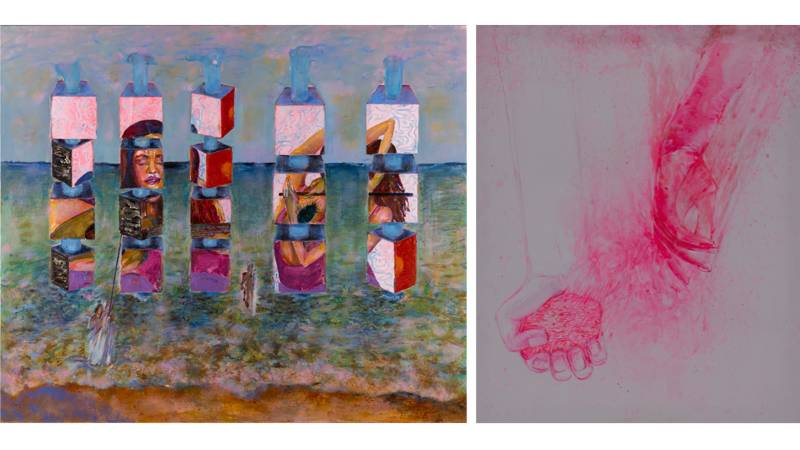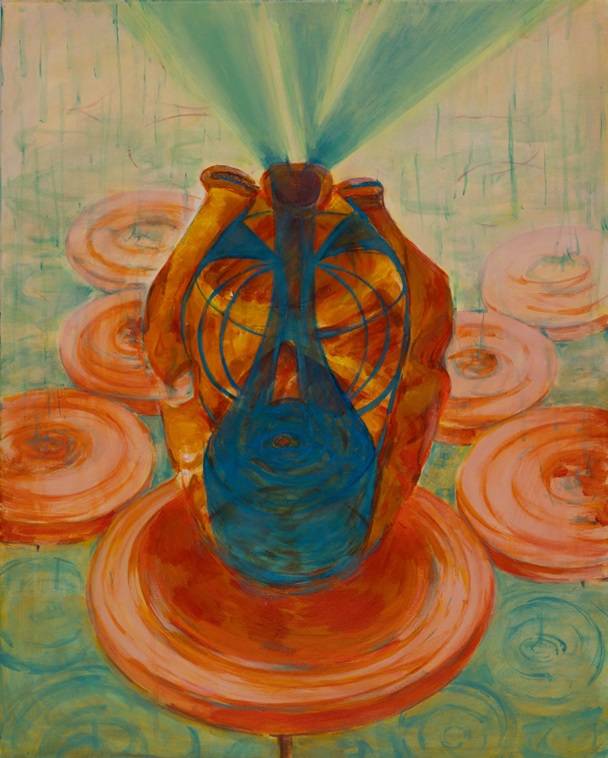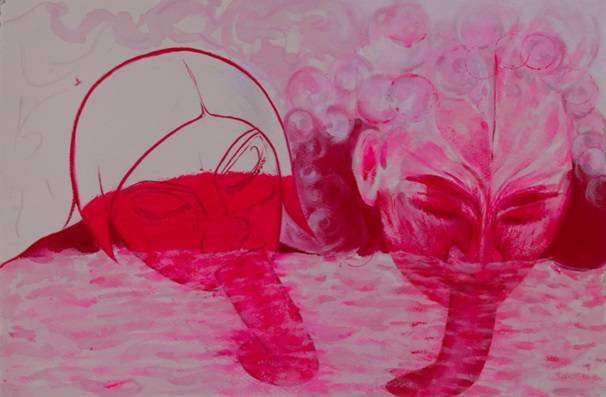
Water and its long-lived, inextricable association with mysticism throughout history has been interpreted and depicted through the symbolic language of dreams and the arts, with intuition, emotion, healing and oracular inspiration. We hear the waters calling from the rivers, creeks, lakes, seas and even wells – from beneath the ground and within our bloodlines.
In the Celtic lands, it is told that all rivers spring forth from an Otherworld well of wisdom. There is an old story of the 'voices of the wells' - the otherworldly guardian spirits, healers and oracles who tended to the sacred waters and the spiritual wisdom within them. And when these spirits were violated, all the waters retreated and left the world as a barren wasteland, severed from otherworldly wisdom.
Zoya Currimbhoy’s most recent exhibition at the IVS Gallery in Karachi titled “The Spirit of Play” acts as a lens to view and experience life as a series of natural and spontaneous changes that need not be resisted – resulting in sorrow – but allowed to take their own course. As Laozi (Lao Tzu) puts it
“Let Reality be Reality.
Let things flow naturally forward in whatever way they like.”
In Taoism, water symbolises evolution, water appears as the essence of nature and a model for human conduct. It undergoes changes in its form and state, showing us the way to sail through life’s challenges. As water carves out wide curves around and flows through major obstacles, we discover that adaptability, malleability enables or rather propels us forward, undeterred by the nature of landscape.

Currimbhoy’s composition “The Unabandoned Playhouse” belongs to the first body of work in this exhibit, whereby she combines architecture with painting, rigid with fluid, fact with fiction, myth with reality, employing water as not just a signifier in context of visual semiotics but as catalyst triggering a synthesis of merrymaking with the lighthouse. The purpose of combining both to become one is manifested formally through the intentional lacking detail and visual depth in the image. Swaying swings on either side and balanced beams of light emitted through the light source on top add to the harmony and sanctity of the overall composition thereby transforming the functional structure into a holy site/temple.
Another composition exuding similar thematic concerns, titled “Seal Song,” consists of two vacant boats floating in the foreground with one situated in the backdrop along the horizon line. Stemming from the boats are exaggerated scaled wind chimes dominating the picture plane and thus setting the tone for the painting. Their repetitive forms and varying proportions move the viewer’s eye within the image creating a sense of rhythm and depth. Seals add to the vitality and dynamism with their trademark childlike playfulness. It almost seems as if they are swimming comedians who aren’t afraid to show off or clown around. Here, Seal Spirit reminds one that humour is wonderful food for the soul.

“Skeleton” imbues a juvenile innocence. When young children explore and interact with the world around them, they engage in play schemas enabling them to develop vital cognitive skills and math concepts like symmetry and geometry. The Rotation Play schema is manifested through an interest in spinning, twirling and turning objects or themselves. The skeleton is a fictionalised morphological study that amalgamates various geometrical architectural forms to depict an armature capable of undergoing shift, a structure possessing endless possibilities, morphable, transforming as opposed to dogmatic, immutable, rigid. Touching on themes of death, decay and rebirth, the work characterises the transitory nature of life and acts as a reminder of our shared humanity: the human condition as vulnerable and mortal.
The second complimenting body of work comprises of monochrome paintings rendered in neon pink—a highly evocative, emotional, and feminine colour. These paintings depict water as a vessel of human connection, reflecting the Baha'is notion of unity between all people and the interrelatedness of all things. In this context, water becomes a fundamental metaphor for the cosmos inhabited by us. Just as water glues together diverse elements of the natural world, simultaneously it weaves a tapestry of experiences and emotions. Together, these bodies of work celebrate water not only as a physical entity but also as a profound source of wisdom and creativity.

Neon Pink symbolises fearless whimsy, extreme sociability, and powerful playfulness. While being an unapologetic rendition of youthfulness, emotion, and networking, it is the sharpest, most full-throttle shade of the pink spectrum without crossing over into red, representing a very active pursuit of the lighter side of life. It takes up space without ever feeling harsh.
Zoya has prudently employed it for movement, active love, new horizons, and self-standards, all rolled into one show-stopping hue. The works “Energy” and “Difference in taste” are flamboyant illustrations of human interconnectivity and co-dependence: individual experiences fused with collective encounters, manifesting the indispensability of real human connection in a world of more virtual interactions than physical.

